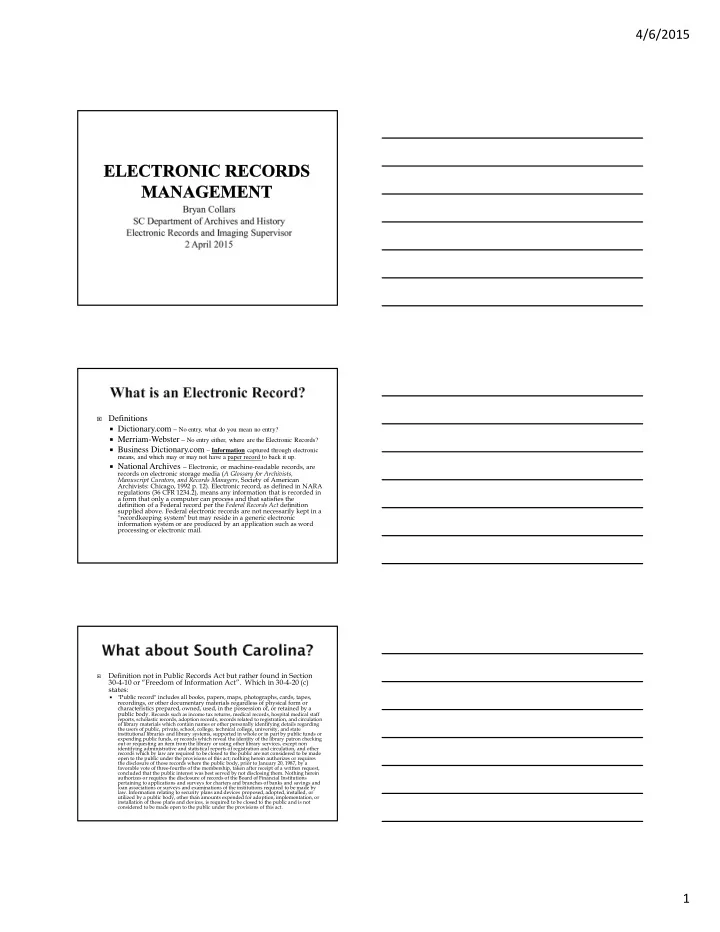

4/6/2015 Definitions Dictionary.com – No entry, what do you mean no entry? Merriam-Webster – No entry either, where are the Electronic Records? Business Dictionary.com – Information captured through electronic means, and which may or may not have a paper record to back it up. National Archives – Electronic, or machine-readable records, are records on electronic storage media ( A Glossary for Archivists, Manuscript Curators, and Records Managers , Society of American Archivists: Chicago, 1992 p. 12). Electronic record, as defined in NARA regulations (36 CFR 1234.2), means any information that is recorded in a form that only a computer can process and that satisfies the definition of a Federal record per the Federal Records Act definition supplied above. Federal electronic records are not necessarily kept in a "recordkeeping system" but may reside in a generic electronic information system or are produced by an application such as word processing or electronic mail. Definition not in Public Records Act but rather found in Section 30-4-10 or “Freedom of Information Act”. Which in 30-4-20 (c) states: "Public record" includes all books, papers, maps, photographs, cards, tapes, recordings, or other documentary materials regardless of physical form or characteristics prepared, owned, used, in the possession of, or retained by a public body. Records such as income tax returns, medical records, hospital medical staff reports, scholastic records, adoption records, records related to registration, and circulation of library materials which contain names or other personally identifying details regarding the users of public, private, school, college, technical college, university, and state institutional libraries and library systems, supported in whole or in part by public funds or expending public funds, or records which reveal the identity of the library patron checking out or requesting an item from the library or using other library services, except non identifying administrative and statistical reports of registration and circulation, and other records which by law are required to be closed to the public are not considered to be made open to the public under the provisions of this act; nothing herein authorizes or requires the disclosure of those records where the public body, prior to January 20, 1987, by a favorable vote of three-fourths of the membership, taken after receipt of a written request, concluded that the public interest was best served by not disclosing them. Nothing herein authorizes or requires the disclosure of records of the Board of Financial Institutions pertaining to applications and surveys for charters and branches of banks and savings and loan associations or surveys and examinations of the institutions required to be made by law. Information relating to security plans and devices proposed, adopted, installed, or utilized by a public body, other than amounts expended for adoption, implementation, or installation of these plans and devices, is required to be closed to the public and is not considered to be made open to the public under the provisions of this act. 1
4/6/2015 According to South Carolina’s “Public Record Act” "Public record" includes all books, papers, maps, photographs, cards, tapes, recordings, or other documentary materials regardless of physical form or characteristics prepared, owned, used, in the possession of, or retained by a public body. Born Digital = created in an electronic environment i.e. emails, word.docx Digitized = created in a non- electronic environment and converted to an electronic means i.e. scan of a signed form Digital Object = any electronic file, regardless if it is an official record. Example: draft of a speech, some logos Electronic Record = a digital object that is an official record based on a retention schedule. A record is a record regardless of format Public Records act does not specify formats Legal considerations Public Records Act Uniform Electronic Transactions Act FOIA Litigation discovery When to start? Immediately 2
4/6/2015 Essential starting point Controlled access to official records Restrictions to editing Naming conventions Audit trails Metadata to retain about the record Documenting the system EDRMS: Electronic Document Records Management System ERMS: Electronic Records Management System Not the same as a CMS (Content Management System) 3
4/6/2015 Interpares Project http://www.interpares.or g/ International project regarding preservation of electronic records ISO 15489 International Standards http://www.iso.org/iso/ Organization guide to home.html proper records management and record- keeping systems DoD 5015.2 Dept of Defense guidelines for system functionality Many systems compliant with these standards Exportability Exit strategy Can you get a copy of When the system is the record from the outdated or no longer system for transfer to used, how will you other get all of the data agencies/people? out? Example: can you Built into contract? send an electronic copy of the record to the archives with all the required metadata? SCDAH PUBLICATIONS EXAMPLE TIS CRITERIA EDRMS guidelines: Internal/external Trustworthy Information security options System (TIS) guidelines Ability to document Guidelines available at the how the system works Archives website Helps inform policy User identification decisions Audit trails for each TIS does not condone a record specific provider/product Provides a checklist to guide decision-making process 4
4/6/2015 <metadata>Don’t PANIC</metadata> Metadata is… Descriptive information use to keep track of and understand a record or digital object. Includes analog records Example: paper filing system Often embedded in the digital object during creation <titlestmt> Why comply? <titleproper></titlepro Interoperability per> with other systems <author></author> Usability for the <sponsor></sponsor> public </titlestmt> <titlestmt> <titleproper></titlepro per> <author></author> </titlestmt> 5
4/6/2015 There can be only one…official record The rest are use/convenience copies Need to identify who owns official record Records are not tied to a specific medium Need to create a strong definition of what is or isn’t a record in your agency Agency responsible to preserve electronic records Need to ensure accessibility over time Migration to newer formats Determine essential record characteristics i.e. is it a picture or a document? HIGHLY RECOMMENDED: metadata about electronic records system and format. How much access and to whom? Physical security Disaster recovery and security copies 6
4/6/2015 7
Recommend
More recommend